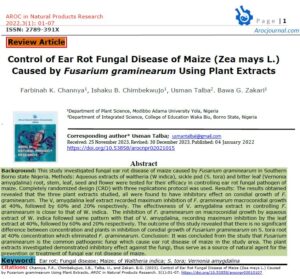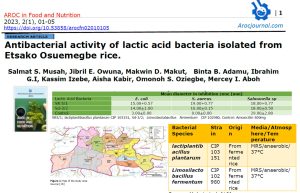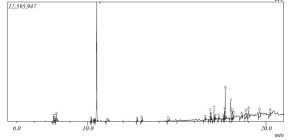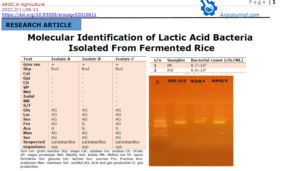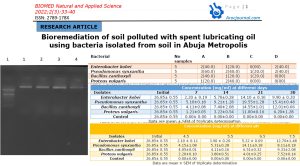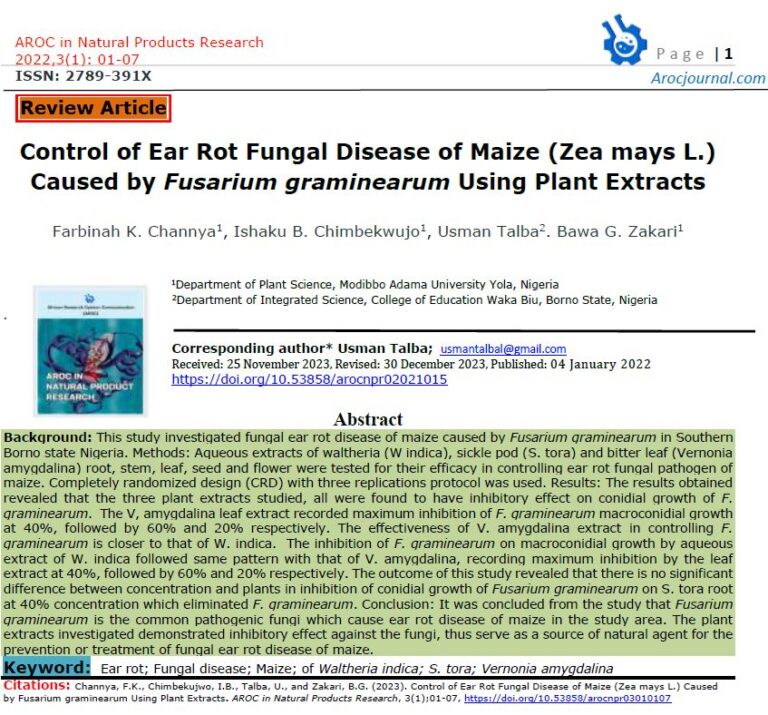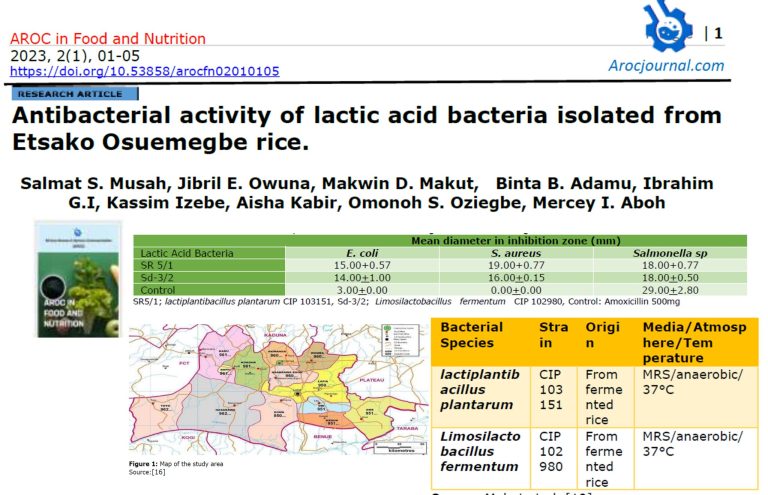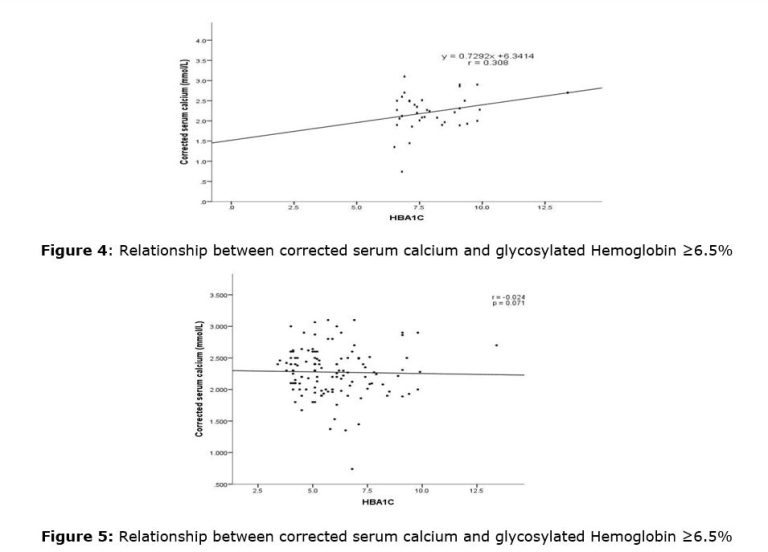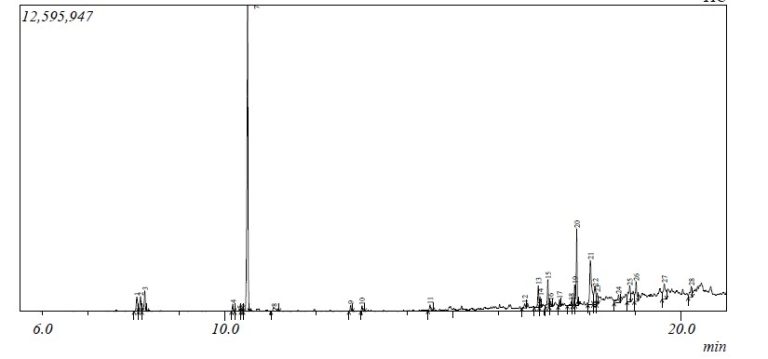1.0 Introduction
Hydrocarbons are a class of organic chemical compounds that serve as the principal constituents of petroleum and natural gas [1]. They serve as fuels, lubricants and as raw materials for the production of plastics, fibres, solvents, explosives and industrial chemicals. Hydrocarbons are considered to be the primary source of energy throughout the world as they serve as fuel.
A large amount of fuel is required, especially for transportation, industrial production and lubrication [2]. With the industrial development and enlargement of human activities, the increasing incidence of petroleum pollution has drawn more public concern. Human activities are the main source of significant hydrocarbon release to the environment [3]. The presence of different types of automobiles and machinery has resulted in an increase in the use of lubricating oil [4]. Also, oil spills from industries, filling stations, loading and pumping stations, petroleum product depots during transportation and at auto mechanic workshops, all combine to contribute to soil pollution [5].
Soil pollution with hydrocarbons causes extensive damage to local systems, since the accumulation of pollutants in animals and plant tissues may cause death or mutations [6]. The maintenance of soil quality is a major concern of agronomists and soil scientists as hydrocarbon pollutions are dangerous to both animals and plants, due to their carcinogenic and mutagenic effects [7]
The problems of pollutions have resulted in the exploration of various remedial approaches to aid the cleanup of polluted soils [8]. A variety of technologies are currently available to treat soil contaminated with hazardous materials, including excavation and containment in secured landfills, vapour extraction, stabilization and solidification, soil flushing, soil washing, solvent extraction, etc. [9]. Many of these technologies, however, are either costly or do not result in complete destruction of pollution.
There is, therefore, an increasing interest in cheap and eco-friendly remediation processes via the use of bioremediation [4]. Bioremediation is a natural process that relies on bacteria, fungi and plants to degrade pollutants as they carry out their normal life functions [9]. Bioremediation entails the application of biological processes involving enzymatic activities of microorganisms to degrade, transform and or essentially remove pollutants resulting from the accidental discharge of petroleum products and industrial processes in our environment [9].
Many microorganisms have the ability to utilize hydrocarbons as the sole source of carbon, as energy for metabolic activities and these microorganisms are widely distributed in nature [9]. The ability to isolate certain hydrocarbon-degrading microorganisms from the oil-polluted environments is evidence that these microorganisms are the active degraders of hydrocarbon pollutants in the environment [1]. This study aimed at assessing the hydrocarbon-degrading potential of some bacteria and fungi isolated from hydrocarbon-contaminated soil (Mechanic workshops) in Keffi, Nasarawa State.
2.0 Materials and Methods
2.1 Chemicals and Reagents
The chemicals employed in this study included Kovac’s reagent, Lactophenol cotton blue reagent, peptone water, saline, gentian violet, methanol, iodine, safranin, indole reagent, methyl red, phosphate buffer, acetate buffer, hydrogen peroxide (H 2O2), slides, petroleum products (engine oil, gear oil and petrol). Microbiological media included Nutrient Agar, Mineral Salt Agar & Broth (Mineral Salt Medium), Sabouraud Dextrose Agar, Citrate Agar, Urea Agar, were employed.
2.2 Description of the Study Area
This research was carried out in Keffi, Nassarawa State, Nigeria. Keffi is approximately 128km from Lafia, the state capital and 68km from Abuja, the Federal Capital Territory. Keffi is located between latitude 80 5 N of the equator and longitude 708 E and situated on an altitude of 850m above sea level [10]
2.3 Sample Collection
Five sampling sites (Mechanic workshops) were chosen randomly and sampled. From each of the sampling sites, subsoil of 15-30cm depth was collected for microbiological analysis. Forty (40) grams of soil was collected at each sampling site using a sterile spatula at the auto-mechanic workshops. The subsoil sample was collected at 15 – 30cm down the soil horizon. The soil samples collected were transferred into well labeled, sterile sample containers. The collected soil samples were arranged in a box and transported to the laboratory for microbial analysis.
2.4 Isolation of hydrocarbon utilizing microorganisms
The isolation of hydrocarbon utilizing organisms was performed using mineral salt broth (MSB) for enrichment and mineral salt agar (MSA) for cultivation. For each of the soil samples, 20.0 grams was inoculated into 180 ml of Mineral salt broth which was prepared by dispensing 27.8 grams of the medium in 1000 ml distilled water and sterilized by autoclaving at 15 lbs pressure (121°C) for 15 minutes. The mixture was shaken thoroughly to produce a well-dispersed solution and then incubated at 30ºC for 72 hours. This aided in resuscitating the stressed microorganisms present in the sample. The mixture was serially diluted (10-1 to 10-5) from the stock sample using sterile distilled water. The procedure used is a modification of Prakash, et al. [1].
2.5 Hydrocarbon utilization assay
The microbial isolates were screened for their ability to utilize hydrocarbons as the sole carbon source using the mineral salt medium. petrol, gear oil and engine oil served as sources of hydrocarbons which were incorporated into the MSM. The method employed was adapted from Ekanem and Ogunjobi, [11]. The MSM (9.0ml) was dispensed into test tubes. Into each of the test tubes, 1.0ml of the respective hydrocarbons (petrol, engine and gear oil) was added. After capping, all the test tubes were sterilized at 121o C for 15 minutes and allowed to cool. On cooling, the first set of the test tubes was inoculated with 0.1ml of the respective bacterial Isolates. The test tubes serving as control were not inoculated. All the test tubes were incubated in a Shaker Incubator at 150rpm at 30oC for 14 days after which each tube was scored for optical density (OD) using UV- Visible Spectrophotometer. The optical density of the culture was measured at about 580 nm. Utilization (mg/ml) higher than the controls was taken as an indication of hydrocarbon utilization.
2.6 Effect of pH on hydrocarbon utilizing efficiencies of the microorganisms
Using a modification of Olowomofe et al. [12], the effect of pH in the microbial degradation of hydrocarbons was assessed. 200ml of Mineral Salt Medium (MSM) Broth was prepared in two Erlenmeyer flasks and the pH of the broth medium was adjusted to pH 4.5 and 8.5 using acetate buffer for acidic pH and phosphate buffer for alkaline pH. 10ml of the broth medium was dispensed into test tubes, in each of the test tubes, 1ml of either of the respective hydrocarbon products (petrol, engine oil and gear oil) was added.
This was sterilized at 121°C for 15 minutes. On cooling, 0.1ml of the inoculum was introduced into the broth medium and incubated at 37°C for 7 days. The microbial growth was assessed by measuring the optical density at 580nm after 7 days, using the UV-Visible Spectrophotometer.
2.7 Effect of temperature on hydrocarbon utilizing efficiencies of the microorganisms
This test evaluated the effect of temperature in the microbial degradation of hydrocarbons. According to Olowomofe et al. [12], 9ml of already prepared MSM broth was dispensed into each of the test tubes and 1ml of the respective hydrocarbon products (petrol, engine oil and gear oil) was dispensed into each test tube (this was done in duplicates) and further sterilized at 121°C for 15 minutes. On cooling, 0.1ml of each inoculum was introduced into the prepared MSM broth and incubated at 25°C and 37°C for 7 days, after which the optical density was measured at 580nm using the UV-Visible Spectrophotometer.
2.8 Effect of time on hydrocarbon utilizing efficiencies of the microorganisms
This test evaluated the impact of time in the microbial degradation rate of hydrocarbons. According to Olowomofe et al. [12], 9ml of already prepared MSM broth was dispensed into each of the test tubes and 1ml of the respective hydrocarbon products (petrol, engine oil and gear oil) was dispensed into each test tube (this was done in duplicates) and further sterilized at 121°C for 15 minutes and allowed to cool. The medium was adjusted to a neutral pH (7). 0.1ml of each inoculum was introduced into the prepared MSM broth and incubated at 37°C for 28 days. At an interval of 7 days, the optical density was measured at 580nm using the UV-Visible Spectrophotometer.
2.9 Effect of microbial consortia (microcosms) on hydrocarbon utilizing efficiencies of the microorganisms
This test was carried out using a modification of Olowomofe et al. [12], A 9ml of already prepared MSM broth was dispensed into each of the test tubes and 1ml of the respective hydrocarbon products (petrol, engine oil and gear oil) was dispensed into each test tube (this was done in duplicates) and further sterilized at 121°C for 15 minutes. On cooling, the microcosm consisting of different microorganisms was inoculated and incubated at 37°C for 14 days, after which the optical density was measured at 580 nm using the UV-Visible Spectrophotometer.
2.10 Data analysis
All analysis was conducted in triplicate and analyzed using statistical package for social science (SPSS) version 16 and presented as means ± standard error of the mean.
3.0 Results
3.1 Hydrocarbon Utilizing Microorganisms Isolated from Soil
Isolates that were screened for hydrocarbon utilization were observed as presented in Table 1. The hydrocarbon utilization of petroleum by the microorganism ranges between 0.246±0.07 to 1.35±0.037 mg/mL been highest in Alcaligenes sp and lowest in Enterobacter sp. The hydrocarbon utilization from the gear oil ranges between 0.083±0.023 to 0.68±0.03 been highest in Pseudomonas sp and lowest in Citrobacter sp, while hydrocarbon utilization from the engine oil ranges between 0.173±0.008 to 1.05±0.053 mg/mL been highest in Alcaligenes sp and lowest in Aspergillus sp (Table 1)
Table 1: Hydrocarbon Utilizing Microorganisms Isolated from Soil
| Hydrocarbon Utilization (mg/mL) | |||
| Isolates | PT | GO | EO |
| Pseudomonas sp | 0.95±0.04 | 0.68±0.03 | 0.85±0.027 |
| Alcaligenes sp | 1.33±0.035 | 0.65±0.02 | 1.05±0.053 |
| Staphylococcus sp | 0.257±0.012 | 0.026±0.03 | 0.175±0.011 |
| Pseudomonas sp | 0.263±0.05 | 0.143±0.04 | 0.238±0.031 |
| Citrobacter sp | 0.253±0.042 | 0.083±0.023 | 0.193±0.033 |
| Proteus sp | 0.36±0.026 | 0.216±0.034 | 0.27±0.02 |
| Enterobacter sp | 0.246±0.07 | 0.125±0.022 | 0.235±0.04 |
| Trichoderma sp | 1.35±0.037 | 0.57±0.024 | 0.64±0.01 |
| Purpureocillium sp | 0.95±0.024 | 0.34±0.033 | 0.62±0.031 |
| Aspergillus sp Control | 0.276±0.017 0.086±0.017 | 0.128±0.012 0.009±0.02 | 0.173±0.008 0.028±0.013 |
Key: B= Bacteria isolate, F= Fungi isolate, PT= petrol. GO= gear oil, EO= engine oil
3.2 Effect of pH on hydrocarbon utilizing efficiencies of the microbial isolates
The utilization rate of hydrocarbon products by Pseudomonas aeruginosa, Alcaligenes faecalis, Trichoderma harzianum and Purpureocillium lilacinum over varying pH levels was observed as presented in table 2. The effect of pH on the utilization rate of hydrocarbon products (petrol, gear and engine oil) for Pseudomonas aeruginosa at pH 8.5 ranges from 0.68±0.02 to 0.26±0.03 mg/ml while at pH 4.5, it ranges from 0.53±0.05 to 0.21±0.02 mg/ml. Alcaligenes faecalis at pH 8.5 ranges from 0.97±0.01 to 0.31±0.02 mg/ml while at pH 4.5, it ranges from 0.82±0.03 to 0.33±0.01. Trichoderma harzianum at pH 8.5 ranges from 0.67±0.13 to 0.32±0.03 mg/ml while at pH 4.5, it ranges from 0.96±0.04 to 0.33±0.01. Purpureocilium lilacinum at pH8.5 ranges from 0.31±0.02 to 0.26±0.03 mg/ml while at pH 4.5, it ranges from 0.52±0.04 to 0.29±0.03 mg/ml.
Table 2: Effect of pH on hydrocarbon utilizing efficiencies of the microbial isolates
| Hydrocarbon Utilization (mg/ml) | |||||||
| pH = 8.5 | pH = 4.5 | ||||||
| PT | GO | EO | PT | GO | EO | ||
| Pseudomonas aeruginosa | 0.68±0.02 | 0.26±0.03 | 0.52±0.02 | 0.53±0.05 | 0.21±0.02 | 0.48±0.05 | |
| Alcaligenes faecalis | 0.97±0.01 | 0.31±0.02 | 0.77±0.04 | 0.82±0.03 | 0.31±0.04 | 0.53±0.034 | |
| Trichoderma harzianum | 0.67±0.13 | 0.58±0.04 | 0.32±0.03 | 0.96±0.04 | 0.33±0.01 | 0.41±0.007 | |
| Purpureocillium lilacinum | 0.31±0.02 | 0.26±0.03 | 0.29±0.04 | 0.52±0.04 | 0.29±0.03 | 0.35±0.032 |
Key: PT= petrol, GO= gear oil, EO= engine oil
3.3 Effect of temperature on hydrocarbon utilizing efficiencies of the microbial isolates
The effect of temperature on the utilization rate of hydrocarbon products (petrol, gear and engine oil) for Pseudomonas aeruginosa at 25°C ranges from 0.58±0.03 for petrol, 0.23±0.027 for gear oil and 0.46±0.05 for engine oil while at 37°C, it ranges from 0.71±0.034 for petrol, 0.48±0.03 for gear oil and 0.56±0.036 for engine oil. Alcaligenes faecalis at 25°C ranges from 0.71±0.026 for petrol, 0.22±0.004 for gear oil and 0.55±0.04 for engine oil while at 37°C, it ranges from 1.01±0.027 for petrol, 0.53±0.041 for gear oil and 0.79±0.04 for engine oil. Trichoderma harzianum at 25°C ranges from 0.98±0.03 for petrol, 0.48±0.032 for gear oil and 0.71±0.011 for engine oil while at 37°C, it ranges from 0.98±0.031 for petrol, 0.45±0.032 for gear oil and 0.59±0.012 for engine oil. Purpureocilium lilacinum at 25°C ranges from 0.82±0.024 for petrol, 0.27±0.023 for gear oil and 0.35±0.046 for engine oil while at 37°C, it ranges from 0.75±0.023 for petrol, 0.33±0.021 for gear oil and 0.56±0.046 for engine oil (Table 3)
Table 3: Effect of temperature on hydrocarbon utilizing efficiencies of the microbial isolates
| Hydrocarbon Utilization ( mg/ml) | |||||||
| Temperature=25°C | Temperature=37°C | ||||||
| PT | GO | EO | PT | GO | EO | ||
| Pseudomonas aeruginosa | 0.58±0.03 | 0.23±0.027 | 0.46±0.05 | 0.71±0.034 | 0.48±0.03 | 0.56±0.036 | |
| Alcaligenes faecalis | 0.71±0.026 | 0.22±0.004 | 0.55±0.04 | 1.01±0.027 | 0.53±0.041 | 0.79±0.04 | |
| Trichoderma harzianum | 0.98±0.03 | 0.49±0.032 | 0.71±0.011 | 0.98±0.031 | 0.45±0.032 | 0.59±0.012 | |
| Purpureocillium lilacinum | 0.82±0.024 | 0.27±0.023 | 0.35±0.046 | 0.75±0.023 | 0.33±0.021 | 0.56±0.046 |
Key: PT= petrol, GO= gear oil, EO= engine oil
3.4 Effect of time duration on hydrocarbon utilizing efficiencies of the microbial isolates
The utilization rate of hydrocarbon products by Pseudomonas aeruginosa, Alcaligenes faecalis, Trichoderma harzianum and Purpureocillium lilacinum was assessed at a weekly interval, over a period of 28 days. The results revealed that the hydrocarbon utilization from the petrol, gear and engine oil by all the microorganisms including Pseudomonas aeruginosa, Alcaligenes faecalis, Trichoderma harzianum and Purpureocillium lilacinum increases with increase in time from day 1 to day 28 (Table 4). Alcaligenes faecalis demonstrated the highest hydrocarbon utilization ability in the range of 1.57±0.031 to 2.20±0.02 at day 28 while Purpureocillium lilacinum with the hydrocarbon utilizing efficiency range between 0.92±0.006 to 1.98±0.03 mg/ml demonstrated the least (Table 4).
3.5 Effect of microbial consortium on hydrocarbon utilizing efficiencies of the microbial isolates
The microbial consortium for the utilization of hydrocarbon products (petrol, gear and engine oil) at a standard temperature of 37°C, pH7 and time of 14 days for Pseudomonas aeruginosa and Alcaligenes faecalis ranges from 1.83±0.035 mg/ml for petrol, 1.33±0.023 mg/ml for gear oil and 1.46±0.015 mg/ml for engine oil. A microbial consortium of Trichoderma harzianum and Purpureocillium lilacinum ranges from 1.88±0.041 for petrol, 1.45±0.026 for gear oil and 1.63±0.011 for engine oil, while a microbial consortium of Pseudomonas aeruginosa, Alcaligenes faecalis, Trichoderma harzianum and Purpureocillium lilacinum range from 2.09±0.002 mg/ml for petrol, 1.85±0.031 mg/ml for gear oil and 1.97±0.034 mg/ml for engine oil (Table 5).
Table 4: Effect of time duration on hydrocarbon utilizing efficiency of the microbial isolates
| Hydrocarbon Utilization(mg/ml) | |||
| Pseudomonas aeruginosa | PT | GO | EO |
| Day 1 | 0.31±0.033 | 0.12±0.07 | 0.28±0.025 |
| Day 7 | 0.88±0.011 | 0.35±0.023 | 0.51±0.031 |
| Day 14 | 0.95±0.04 | 0.68±0.03 | 0.85±0.027 |
| Day 21 | 1.21±0.031 | 0.75±0.015 | 1.04±0.02 |
| Day 28 | 1.97±0.05 | 1.31±0.034 | 1.52±0.035 |
| Alcaligenes faecalis | PT | GO | EO |
| Day 1 | 0.5±0.02 | 0.07±0.007 | 0.35±0.031 |
| Day 7 | 0.98±0.026 | 0.33±0.023 | 0.89±0.05 |
| Day 14 | 1.33±0.035 | 0.65±0.02 | 1.05±0.053 |
| Day 21 | 1.84±0.04 | 1.24±0.032 | 1.47±0.043 |
| Day 28 | 2.20±0.02 | 1.57±0.031 | 1.86±0.034 |
| Trichoderma harzianum | PT | GO | EO |
| Day 1 | 0.38±0.022 | 0.09±0.023 | 0.21±0.14 |
| Day 7 | 0.76±0.043 | 0.33±0.017 | 0.36±0.021 |
| Day 14 | 1.35±0.037 | 0.57±0.024 | 0.64±0.01 |
| Day 21 | 1.74±0.031 | 1.1±0.013 | 0.95±0.014 |
| Day 28 | 1.98±0.012 | 1.23±0.003 | 1.73±0.008 |
| Purpureocillium lilacinum | PT | GO | EO |
| Day 1 | 0.095±0.001 | 0.06±0.003 | 0.09±0.002 |
| Day 7 | 0.37±0.012 | 0.15±0.04 | 0.28±0.043 |
| Day 14 | 0.95±0.024 | 0.34±0.033 | 0.62±0.031 |
| Day 21 | 1.27±0.023 | 0.73±0.025 | 0.91±0.013 |
| Day 28 | 1.98±0.03 | 0.92±0.006 | 1.39±0.035 |
Key: PT= petrol, GO= gear oil, EO= engine oil
Table 5: Effect of microbial consortium on hydrocarbon utilizing efficiencies of the microbial isolates
| Hydrocarbon Utilization (mg/ml) | |||
| PT | GO | EO | |
| B1 B2 F1 F2 B1 + B2 | 0.95±0.04 1.33±0.035 1.35±0.037 0.95±0.024 1.83±0.035 | 0.68±0.03 0.65±0.02 0.57±0.024 0.34±0.033 1.33±0.023 | 0.85±0.027 1.05±0.053 0.64±0.01 0.62±0.031 1.46±0.015 |
| F1 + F2 | 1.88±0.041 | 1.45±0.026 | 1.63±0.011 |
| B1 + B2+ F1 +F2 | 2.09±0.002 | 1.85±0.031 | 1.97±0.034 |
Key: B1= Pseudomonas aeruginosa, B2= Alcaligenes faecalis, F1= Trichoderma harzanium, F2= Purpureocilium lilacinum, PT= petrol, GO= gear oil, EO= engine oil
4.0 Discussion
The presence of residues of hydrocarbon products in the environment has been reported to have a wide range of hazardous effects including the alteration of the atmosphere and impairment of both plants and animal health [13]. This study assessed the potential of both bacteria and fungi isolated from the soil environment in keffi to degrade hydrocarbon products (petrol, gear oil and engine oil by utilizing them). The ability of certain fungi to utilize hydrocarbon products as their source of carbon shows the degradation potential of such fungi [14]. The results of this study agree with Dacco et al. [15], they evaluated the hydrocarbon-degrading ability of Trichoderma species and the results of their study inferred that Trichoderma harzianum has the capacity to degrade used engine oil, significantly changing the oil composition. Their study also suggested that the genus Trichoderma, has a great range of substrate utilization, hence its high potential and application as an environmental remediation agent. In a similar review, Zafra et al. [16] stated that Trichoderma harzianum is associated with the ability to metabolize both high and low molecular weight polycyclic aromatic hydrocarbons (PAHs). Benguenab and Chibani, [17] in their study, assessed the biodegradation of petroleum hydrocarbons by filaments fungi, Aspergillus austus and Purpureocillium lilacinum. They reported Purpureocillium lilacinum to have a higher degradation potential as it degraded up to 45% used engine oil.
This study revealed the rate of utilization of hydrocarbon products by bacteria was higher in Alcaligenes faecalis, compared to Pseudomonas aeruginosa. This agrees with the reports of Oyewole et al. [18]. Among the fungi, Trichoderma harzianum revealed a higher utilization rate of the hydrocarbon compared to Purpureocillium lilacinum. This study further assessed the impact of time, pH, temperature and microbial consortium in the hydrocarbon utilization rate of microorganisms. At the 25°C, the utilization rate for Pseudomonas aeruginosa and Alcaligenes faecalis was observed to decrease. This could be attributed to the decrease of the metabolic activities of these species at lower temperatures [19]. However, the fungi Trichoderma harzianum and Purpureocillium lilacinum exhibited a higher utilization rate of hydrocarbons at 25°C, this could be attributed to the increased metabolic activities of fungi at low temperatures. This finding corresponds with Oyewole et al. [18], This further implies that the temperature of the environment is a major factor influencing the rate of hydrocarbon utilization and degradation by microorganisms. Ribicic et al. [20] suggested that increased temperature increases the degradation rate for bacterial while fungi have an optimum degradation rate at lower temperatures, although their ability to degrade hydrocarbons can occur over a wide temperature range.
The pH of the environment is important in biodegradation as it affects processes such as cell membrane transport [21]. The findings of this study revealed that bacteria have a higher hydrocarbon utilization rate in neutral to alkaline pH while fungi are tolerant to acidic conditions. This corresponds with the findings of Oyewole et al. [18].
The effect of time in hydrocarbon biodegradation was assessed in this study, over a period of 28 days. The utilization rate of hydrocarbons by both bacteria and fungi was observed to progressively increase over the 28 days interval. This aligns with a report by Mukherjee et al. [22], their study results showed that sufficient time is needed for effective biodegradation by microorganisms. Thus, while the process of bioremediation through biodegradation may be cost-effective, it is time-dependent.
The findings of this study show that microbial consortium plays a significant role in Hydrocarbon biodegradation. While this study did not evaluate the processes involved in the degradation of hydrocarbons, it revealed that the higher the number of microbial species present, the higher the degradation rate [23]. The hydrocarbon utilization rate for all the isolates combined (Pseudomonas aeruginosa, Alcaligenes faecalis, Trichoderma harzianum and Purpureocillium lilacinum), was higher than the hydrocarbon utilization rate for the individual bacteria combined and the fungi combined. These findings correspond with previous studies by Tao et al. [24] and Wang et al. [25], both studies revealed that microbial consortium had a higher degradation rate compared to individual microorganisms.
The findings of this study also revealed that the microbial utilization rate of the hydrocarbon products was highest in petrol and lowest in gear oil. This could be attributed to the high viscosity of gear oil when compared with petrol and engine oil. Subathra et al. [19], reported similar observations, they further explained that the increased viscosity of hydrocarbon products reduces the microbial utilization rate of the hydrocarbons.
5.0 Conclusion
The findings of this study show that bacteria species such as Pseudomonas aeuriginosa and Alcaligenes faecalis and fungi species such as Trichoderma harzianum and Purpureocilium lilacinum are effective degraders of hydrocarbon products. While they individually have the potential to degrade hydrocarbon, they degrade hydrocarbon best as a microbial consortium and the degradation rate progresses with time. Thus, the effectiveness of biodegradation is subject to multiple factors such as time, temperature, pH, microbial species present and nutrient availability.
Conflict of Interest: The author declared no conflict of interest exist
Ethical Approval: Not applicable
Authors contributions: The work was conducted in collaboration of all authors. All authors read and approved the final version of the manuscript.
References
1. Prakash, A.; Bisht, S.; Singh, J.; Teotia, P.; Kela, R.; Kumar, V. Biodegradation potential of petroleum hydrocarbons by bacteria and mixed bacterial consortium isolated from contaminated sites. Turkish journal of Engineering and Environmental sciences 2014, 38, 41-50.
2. Nikhil, T.; Deepa, V.; Rohan, G.; Satish, B. Isolation, characterization and identification of diesel engine oil degrading bacteria from garage soil and comparison of their bioremediation potential. International Research Journal of Environment Sciences 2013, 2, 48-52.
3. Mikkonen, A. The potential of microbial ecological indicators to guide ecosophisticated management of hydrocarbon-contaminated soils. 2012.
4. Lawson, I.; Nartey, E.; Darko, D.; Okrah, V.; Tsatsu, D. Microbial degradation potential of some Ghanaian soils contaminated with diesel oil. Agriculture and Biology Journal of North America 2012, 3, 1-5.
5. Onuoha, S.; Olugbue, V.; Uraku, J.; Uchendu, D. Biodegradation potentials of hydrocarbon degraders from waste lubricating oil-spilled soils in Ebonyi State, Nigeria. Int. J. Agric. Biol 2011, 13, 586-590.
6. Ratledge, C. Biochemistry of microbial degradation; Springer Science & Business Media: 2012.
7. Zhang, C.; Meckenstock, R.U.; Weng, S.; Wei, G.; Hubert, C.R.J.; Wang, J.-H.; Dong, X. Marine sediments harbor diverse archaea and bacteria with the potential for anaerobic hydrocarbon degradation via fumarate addition. FEMS Microbiology Ecology 2021, 97, fiab045.
8. ChaIneau, C.-H.; Morel, J.-L.; Oudot, J. Microbial degradation in soil microcosms of fuel oil hydrocarbons from drilling cuttings. Environmental science & technology 1995, 29, 1615-1621.
9. Ebakota, O.D.; Osarueme, J.O.; Gift, O.N.; Odoligie, I.; Osazee, J.O. Isolation and characterization of hydrocarbon-degrading bacteria in top and subsoil of selected mechanic workshops in Benin City metropolis, Nigeria. Journal of Applied Sciences and Environmental Management 2017, 21, 641-645.
10. Akwa, V.; Binbol, N.; Samaila, K.; Marcus, N. Geographical perspective of Nasarawa state. Onaivi Printing and Publishing Company Limited, Keffi, Nigeria 2007, 2-3.
11. Ekanem, J.; Ogunjobi, A. Hydrocarbon Degradation Potentials of Bacteria Isolated from Spent Lubricating Oil Contaminated Soil. Journal of Applied Sciences & Environmental Management 2017, 21.
12. Olowomofe, T.O.; Oluyege, J.; Sowole, D.O. Isolation, screening and characterization of hydrocarbon-utilizing bacteria isolated from bitumen-contaminated surface water in Agbabu, Ondo State. Journal of Advances in Biology & Biotechnology 2017, 1-9.
13. Nisha, P.; Nayana, M.; Viji, V. Degradation studies on diesel oil using bacterial consortium isolated from oil polluted soil. Advanced BioTech 2013, 13, 6-14.
14. Guru, G.; Gohel, H.; Ghosh, S.; Braganza, V. Isolation and enrichment of microbes for degradation of crude oil. International journal of engineering science and innovative technology 2013, 2, 144-147.
15. Daccò, C.; Girometta, C.; Asemoloye, M.; Carpani, G.; Picco, A.; Tosi, S. Key fungal degradation patterns, enzymes and their applications for the removal of aliphatic hydrocarbons in polluted soils: A review. International Biodeterioration & Biodegradation 2020, 147, 104866.
16. Zafra, G.; Cortés-Espinosa, D.V. Biodegradation of polycyclic aromatic hydrocarbons by Trichoderma species: a mini review. Environmental Science and Pollution Research 2015, 22, 19426-19433.
17. Benguenab, A.; Chibani, A. Biodegradation of petroleum hydrocarbons by filamentous fungi (Aspergillus ustus and Purpureocillium lilacinum) isolated from used engine oil contaminated soil. Acta Ecologica Sinica 2020.
18. Oyewole, O.A.; Raji, R.O.; Musa, I.O.; Enemanna, C.E.; Abdulsalam, O.N.; Yakubu, J.G. Enhanced degradation of crude oil with Alcaligenes faecalis ADY25 and iron oxide nanoparticle. 2019.
19. Subathra, M.K.; Immanuel, G.; Suresh, A.H. Isolation and Identification of hydrocarbon degrading bacteria from Ennore creek. Bioinformation 2013, 9, 150.
20. Ribicic, D.; McFarlin, K.M.; Netzer, R.; Brakstad, O.G.; Winkler, A.; Throne-Holst, M.; Størseth, T.R. Oil type and temperature dependent biodegradation dynamics-combining chemical and microbial community data through multivariate analysis. BMC microbiology 2018, 18, 1-15.
21. Al-Hawash, A.B.; Dragh, M.A.; Li, S.; Alhujaily, A.; Abbood, H.A.; Zhang, X.; Ma, F. Principles of microbial degradation of petroleum hydrocarbons in the environment. The Egyptian Journal of Aquatic Research 2018, 44, 71-76.
22. Mukherjee, A.K.; Bhagowati, P.; Biswa, B.B.; Chanda, A.; Kalita, B. A comparative intracellular proteomic profiling of Pseudomonas aeruginosa strain ASP-53 grown on pyrene or glucose as sole source of carbon and identification of some key enzymes of pyrene biodegradation pathway. Journal of proteomics 2017, 167, 25-35.
23. Das, N.; Chandran, P. Microbial degradation of petroleum hydrocarbon contaminants: an overview. Biotechnology research international 2011, 2011.
24. Tao, K.; Liu, X.; Chen, X.; Hu, X.; Cao, L.; Yuan, X. Biodegradation of crude oil by a defined co-culture of indigenous bacterial consortium and exogenous Bacillus subtilis. Bioresource technology 2017, 224, 327-332.
25. Wang, X.-B.; Chi, C.-Q.; Nie, Y.; Tang, Y.-Q.; Tan, Y.; Wu, G.; Wu, X.-L. Degradation of petroleum hydrocarbons (C6–C40) and crude oil by a novel Dietzia strain. Bioresource technology 2011, 102, 7755-7761.


